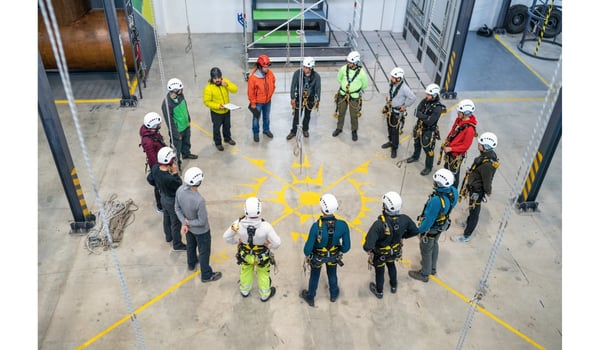Behavioral Safety
What is Behavioural Safety?
Behavioural safety is "the proactive identification and control of human factors that could lead to unsafe acts or conditions." In other words, it's about changing the behaviour of employees in order to create a safer work environment.
Behavioural safety is the proactive identification and mitigation of risks within an organization through changing employee behaviour. By analysing accidents and near-misses, companies can identify at-risk behaviours and work to change them before they lead to an accident.
 Are you working with your employees on behavioural safety to avoid workplace accidents?
Are you working with your employees on behavioural safety to avoid workplace accidents?
The Importance of Behavioural Safety
Behavioural safety programs are ongoing and encompass all employees within an organization. To be effective, these programs must have the full support of management.
In order for employees to buy into the program, they must see that management is committed to making the workplace safe for everyone.
Workplace safety is important for a variety of reasons. First and foremost, it protects employees from injuries.
This not only keeps workers happy and productive, but it also saves companies money in terms of workers’ compensation claims and lost productivity.
In addition, a company with a good safety record is more attractive to potential customers and investors. A commitment to safety shows that a company cares about its employees and is willing to make the necessary changes to protect them.
This level of commitment instils confidence in those who do business with the company. This ultimately helps improve morale in the workplace and improves employee engagement.
Finally, a strong safety program can help prevent lawsuits. If an employee is injured on the job, he or she may be less likely to sue if the company has a solid safety program in place.
This is because the employee will likely believe that the company did everything it could to prevent the accident.
How Behavioural Safety Reduces Workplace Accidents
One of the biggest reasons why behavioural safety is so important is because it can help to prevent accidents before they happen.
By identifying unsafe behaviours and changing them, you can create a work environment that is much less likely to experience an accident.
According to the Occupational Safety and Health Administration (OSHA), "changing hazardous behaviours can reduce injuries by up to 60%."
Not only will this help to keep your employees safe, but it will also save your company money in terms of workers' compensation claims and lost productivity.
In addition to preventing accidents, behavioural safety can also help to improve morale in the workplace. When employees feel like their company is invested in their safety, they are more likely to be engaged and productive.
A study by the National Institute for Occupational Safety and Health (NIOSH) found that "workers who perceive their employers care about their health and safety are three times more likely to report high levels of motivation on the job."
As a result, not only is behavioural safety good for a company’s bottom line, it's also good for employee morale. However, while the benefits of a behavioural safety program are evident, implementing one is not a straightforward process.
How to Implement Behavioural Safety in the Modern Work Environment
Here are some of the steps that organizations can take to implement a behavioural safety program in the workplace.
Create a Culture of Safety
The first step is to create a culture of safety in your workplace. This means that safety should be a priority for everyone from the CEO down to the newest hire.
Employees should know that they are expected to work safely and that unsafe behaviours will not be tolerated. Instilling a safety-first approach is critical, as your frontline employees are directly responsible for actually following through with the program.
Identify Unsafe Behaviours
Once you have created a culture of safety, you can start to identify unsafe behaviours in the workplace. Ask yourself: what are some things that employees do that could lead to an accident?
Common examples include not wearing proper PPE, not following procedures, or not following workplace safety protocols strictly.
An effective option is to start by performing a risk assessment. This will help you identify which behaviours put employees at risk. Once you have identified these behaviours, you can start working on changing them.
Change Unsafe Behaviours
Once you have identified unsafe behaviours, it's time to start changing them. The best way to do this is through training and reinforcement.
Employees should be trained on why certain behaviours are unsafe and what they should do instead. Encouraging safe behaviours through positive reinforcement such as praise, or rewards can also be helpful.
In some cases, you may also need to provide financial incentives or punishments to encourage employees to change their behaviour, though this isn’t always a good approach.
Another way to change behaviour is by redesigning the workplace so that it is not conducive to unsafe behaviours.
For example, if you have identified that employees don’t wear PPE, you can set up PPE stations and set up reminders so that employees are constantly reminded to put on PPE before they go out on the work floor.
Consistency is Key
It's important to be consistent with your approach to Behavioural safety. If you allow employees to get away with unsafe behaviours sometimes, they will think it's okay to do those things all the time.
Similarly, if you only focus on safety when there's an accident, employees will get the message that safety isn't really a priority for your company.
Use EcoOnline to Encourage Behavioural Safety in the Workplace
EcoOnline’s Health & Safety Software allows organizations to record safety behaviours in the workplace. It can be used to analyse incident causation closely to identify any unsafe behaviours.
This information can be used by organizations to report on hazards in the workplace, assess the risks of a job, and to encourage safe behaviour amongst employees.